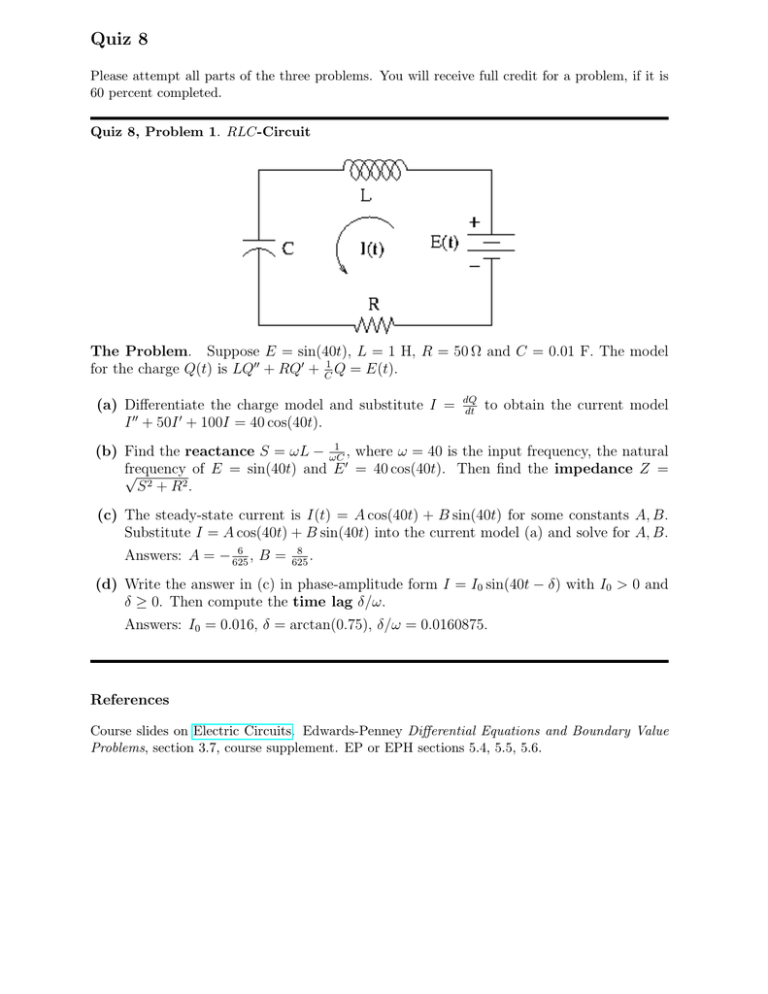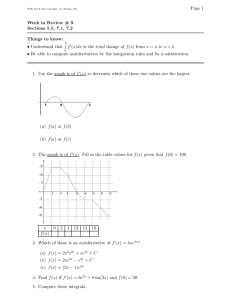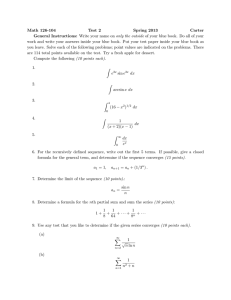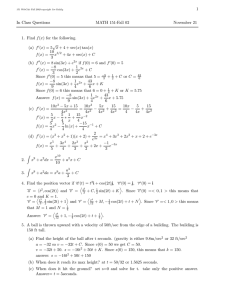Quiz 8
advertisement

Quiz 8 Please attempt all parts of the three problems. You will receive full credit for a problem, if it is 60 percent completed. Quiz 8, Problem 1. RLC-Circuit The Problem. Suppose E = sin(40t), L = 1 H, R = 50 Ω and C = 0.01 F. The model for the charge Q(t) is LQ00 + RQ0 + C1 Q = E(t). (a) Differentiate the charge model and substitute I = I 00 + 50I 0 + 100I = 40 cos(40t). dQ dt to obtain the current model 1 (b) Find the reactance S = ωL − ωC , where ω = 40 is the input frequency, the natural 0 frequency of E = sin(40t) and E = 40 cos(40t). Then find the impedance Z = √ S 2 + R2 . (c) The steady-state current is I(t) = A cos(40t) + B sin(40t) for some constants A, B. Substitute I = A cos(40t) + B sin(40t) into the current model (a) and solve for A, B. 6 Answers: A = − 625 ,B= 8 . 625 (d) Write the answer in (c) in phase-amplitude form I = I0 sin(40t − δ) with I0 > 0 and δ ≥ 0. Then compute the time lag δ/ω. Answers: I0 = 0.016, δ = arctan(0.75), δ/ω = 0.0160875. References Course slides on Electric Circuits. Edwards-Penney Differential Equations and Boundary Value Problems, section 3.7, course supplement. EP or EPH sections 5.4, 5.5, 5.6. Quiz 8, Problem 2. Picard’s Theorem and Spring-Mass Models Picard-Lindelöf Theorem. Let f~(x, ~y ) be defined for ~ |x − x0 | ≤ h, k~y − ~y0 k ≤ k, with f~ and ∂∂~fy continuous. Then for some constant H, 0 < H < h, the problem ( ~y 0 (x) = f~(x, ~y (x)), |x − x0 | < H, ~y (x0 ) = ~y0 has a unique solution ~y (x) defined on the smaller interval |x − x0 | < H. Emile Picard The Problem. The second order problem u00 + 2u0 + 17u = 100, u(0) = 1, u0 (0) = −1 (1) is a spring-mass model with damping and constant external force. The variables are time x in seconds and elongation u(x) in meters, measured from equilibrium. Coefficients in the equation represent mass m = 1 kg, a viscous damping constant c = 2, Hooke’s constant k = 17 and external force F (x) = 100. Convert the scalar initial value problem into a vector problem, to which Picard’s vector theorem applies, by supplying details for the parts below. (a) The conversion uses the position-velocity substitution y1 = u(x), y2 = u0 (x), where y1 , y2 are the invented components of vector ~y . Then the initial data u(0) = 1, u0 (0) = −1 converts to the vector initial data ~y (0) = 1 −1 ! . (b) Differentiate the equations y1 = u(x), y2 = u0 (x) in order to find the scalar system of two differential equations, known as a dynamical system: y10 = y2 , y20 = −17y1 − 2y2 + 100. d~ y (c) The derivative of vector function ~y (x) is written ~y 0 (x) or dx (x). It is obtained by compo! 0 y1 nentwise differentiation: ~y 0 (x) = . The vector differential equation model of scalar y20 system (1) is ! ! 0 1 0 0 ~ ~y (x) + , y (x) = −17 −2 100 ! (2) 1 y (0) = . ~ −1 (d) System (2) fits the hypothesis of Picard’s theorem, using symbols f~(x, ~y ) = 0 1 −17 −2 ! ~y (x) + 0 100 ! , ~y0 = 1 −1 ! . The components of vector function f~ are continuously differentiable in variables x, y1 , y2 , ~ therefore f~ and ∂∂~fy are continuous. Quiz 8, Problem 3. Solving Higher Order Constant-Coefficient Equations The Algorithm applies to constant-coefficient homogeneous linear differential equations of order N , for example equations like y 00 + 16y = 0, y 0000 + 4y 00 = 0, d5 y + 2y 000 + y 00 = 0. dx5 1. Find the N th degree characteristic equation by Euler’s substitution y = erx . For instance, y 00 +16y = 0 has characteristic equation r2 +16 = 0, a polynomial equation of degree N = 2. 2. Find all real roots and all complex conjugate pairs of roots satisfying the characteristic equation. List the N roots according to multiplicity. 3. Construct N distinct Euler solution atoms from the list of roots. Then the general solution of the differential equation is a linear combination of the Euler solution atoms with arbitrary coefficients c1 , c2 , c3 , . . .. The solution space is then S = span(the N Euler solution atoms). Examples: Constructing Euler Solution Atoms from roots. Three roots 0, 0, 0 produce three atoms e0x , xe0x , x2 e0x or 1, x, x2 . Three roots 0, 0, 2 produce three atoms e0x , xe0x , e2x . Two complex conjugate roots 2 ± 3i produce two atoms e2x cos(3x), e2x sin(3x). Explained. The Euler substitution y = erx produces a solution of the differential equation when r is a complex root of the characteristic equation. Complex exponentials are not used directly. Ever. They are replaced by sines and cosines times real exponentials, which are Euler solution atoms. Euler’s formula eiθ = cos θ + i sin θ 3xi −3xi implies e2x cos(3x) = e2x e +e = 12 e2x+3xi + 12 e2x−3xi , which is a linear combina2 tion of complex exponentials, solutions of the differential equation because of Euler’s substitution. Superposition implies e2x cos(3x) is a solution. Similar for e2x sin(3x). The independent pair e2x cos(3x), e2x sin(3x) replaces both e(2+3i)x and e(2−3i)x . Four complex conjugate roots listed according to multiplicity as 2 ± 3i, 2 ± 3i produce four atoms e2x cos(3x), e2x sin(3x), xe2x cos(3x), xe2x sin(3x). Seven roots 1, 1, 3, 3, 3, ±3i produce seven atoms ex , xex , e3x , xe3x , x2 e3x , cos(3x), sin(3x). Two conjugate complex roots a±bi (b > 0) arising from roots of (r −a)2 +b2 = 0 produce two atoms eax cos(bx), eax sin(bx). The Problem Solve for the general solution or the particular solution satisfying initial conditions. (a) y 00 + 4y 0 = 0 (b) y 00 + 4y = 0 (c) y 000 + 4y 0 = 0 (d) y 00 + 4y = 0, y(0) = 1, y 0 (0) = 2 (e) y 0000 + 81y 00 = 0, y(0) = y 0 (0) = 0, y 00 (0) = y 000 (0) = 1 (f) The characteristic equation is (r + 1)2 (r2 − 1) = 0. (g) The characteristic equation is (r − 1)2 (r2 − 1)2 ((r + 1)2 + 9) = 0. (h) The characteristic equation roots, listed according to multiplicity, are 0, 0, −1, 2, 2, 3+4i, 3− 4i, 3 + 4i, 3 − 4i.




